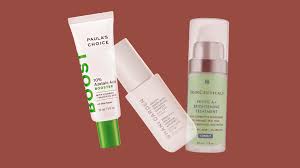
How To Use Niacinamide and Azelaic Acid
With the beauty industry being such a busy hive of must try formulas and hero ingredients reigning supreme, you’ll find there are a few ingredients that enjoy staying under the radar. But today, we are going to shine some light on Azelaic acid and niacinamide and how they can be used together in your daily skincare routine. Hopefully, once we bring both these skin heroes to your attention, you’ll wonder how you ever had a routine without them!
Now, if you’re reading this and thinking to yourself, what on earth is azelaic acid and niacinamide? This next part is for you!
What does Niacinamide do for the skin?
Niacinamide is a form of vitamin B3 and can benefit all skin types due to the fact it has humectant properties. This means niacinamide can draw in moisture into the skin and lock it into place, resulting in the protective skin barrier remains fully functioning. With the skin barrier containing the correct levels of water and oil it can prevent any further damage to the skin caused by exposure to free radical such as pollution, UV rays and other environmental aggressors. Niacinamide also carries the benefits of being able to regulate the sebum production in the skin meaning it can help to rebalance and promote clarity for the complexion.
What does Azelaic Acid do for the skin?
Obtained from various grains, such as barley, wheat and rye and is often formulated in products to work as a leave on exfoliant. It is usually mistaken as being a member of the AHA family, azelaic acid delivers cell communicating skills by “telling” the skin cells on the surface how to behave and over time work at having a smoother, vibrant complexion. It can combat signs of pigmentation and reduce any visible fine lines and wrinkles; it can also help soothe any flare-ups of rosacea. As effective as azelaic acid is at perfecting the skin it can increase photosensitivity so always ensure you a daily SPF of 30 and above.
Can you use niacinamide and azelaic acid together?
You can indeed, what you may find is that niacinamide and azelaic acid form a powerful skin perfecting duo. Whilst azelaic acid is ridding the surface build-up of dead skin cells, bacteria, and impurities whilst niacinamide works at aiding a boost in hydration and restoring the skin barrier to its healthiest state.
When it comes to formulations, you’ll find that niacinamide and azelaic acid are found in products such as serums, face oils and moisturisers. This is an important point to remember as generally these products remain to on the skin for a longer amount of time. This usually results in the potency of each ingredient being a higher percentage meaning you can often see results quicker. With this, it does mean there is a higher risk of irritation and other skin reactions so ensuring you have performed a patch test on the skin beforehand is vital to avoid any of this.
If you wanted to find out more about using niacinamide and azelaic acid together, check out our dedicated blog post.
Do you use niacinamide before azelaic acid?
This first depends on the product each ingredient is formulated in, as I have mentioned in previous posts applying skincare products from thinnest to thickest allows each product to absorb into the skin. If I was to give you my own personal thoughts, I would suggest using a serum enriched in azelaic acid first, followed by a moisturiser packed with niacinamide.
By using the azelaic acid formula first, you are removing the barrier on the surface of the skin created by a build-up of dead skin cells, revealing new skin underneath. Once you have applied niacinamide you’ll maintain the overall health and glowing appearance of your skin with the peace of mind there won’t be any signs of irritation.
What do you not mix with niacinamide?
With its antioxidant and anti-inflammatory properties there are a great deal of skin ingredients to team with niacinamide. With its humectant traits it is helps keep the skin hydrated, soothed and balanced making it an ideal teammate for any other ingredients that are more potent, such as AHA like glycolic acid or BHA such as salicylic acid.
As for skin ingredients that should not be mixed with niacinamide, it is considered that vitamin C delivers similar results and when used together can result in both ingredients counteracting each other rendering them both useless for the skin. Having said that there is nothing stopping you from applying a serum enriched in vitamin C during your morning routine, and niacinamide serum in the evening to reap the rewards with none of the side effects.
Does azelaic acid make you purge?
Yes, it certainly does, but that isn’t necessarily a bad thing. Azelaic acid can speed up the skin cell turn over causing a sudden flare-up in breakouts on the face. This is simply a sign that the azelaic acid is doing its job and ridding the skin of excess sebum, dead skin cells, impurities, and bacteria that in the long run can cause a larger number of problems. Be mindful that if these breakouts are accompanied with discomfort, itching, rashes, or flakiness, this is a sign that azelaic acid is too harsh for your skin and should stop using it instantly. Remember that if you have any concerns with introducing azelaic acid into your routine its best to consult with a doctor or dermatologist to ensure it’s the best ingredient for you and your skin.
Does azelaic acid help with acne scars?
Thanks to azelaic acid helping with skin renewal you’ll find it is able to reduce the appearance of hyperpigmentation and fade dark spots that are often a result of post acne scarring. By sloughing away dead skin cells you’ll find dark spots become lighter over time resulting in them becoming less noticeable to the naked eye. To prevent further sun damage and the overproduction of melanin it is best to remember to apply a daily SPF of 30 and above to prevent further damage from developing.
Should I moisturise before or after azelaic acid?
Taking into consideration the fact that moisturisers have a thick consistency, it is best to apply them at the final stages of your routine. Another benefit of moisturisers is the fact they contain high levels of water and once applied to the skin can help keep the skin surface hydrated and plumped. They are also able to form a protective barrier on the outer layer ensuring any potent ingredients or serums you applied beforehand can work their magic whilst undisturbed from exposure to free radical factors such as UV sun rays, pollution and other environmental aggressors.
So, whether you use niacinamide and azelaic acid separately or teamed together you’ll find they create an overall soothing, hydrating and reviving skin power duo. As always, I would suggest if you were new to these ingredients always check with a doctor or medical professional.
If you have any questions, or just love all things skincare, come, and join us over on Instagram, and don’t forget to check out our latest episode of The Green Sofa over on our YouTube channel.


